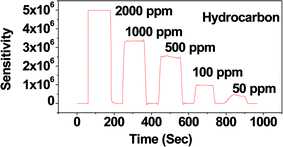High-sensitivity hydrocarbon sensors based on tungsten oxide nanowires†
Abstract
Hydrocarbon (LPG) sensors based on the nanostructures of V2O5 do not exhibit satisfactory characteristics, while sensors based on WO2.72 nanowires show high sensitivity (∼1800) for 2000 ppm of LPG at 200 °C as well as relatively short recovery and response times. Impregnation of WO2.72 nanowires with Pt in the 0.1–1.0 at% range, significantly improves the sensor characteristics, the sensitivity increasing with Pt concentration and reaching a value of ∼106 for 2000 ppm of LPG in the 100–200 °C range with 1 at% Pt. The sensitivity remains high even for 50 ppm of LPG, and is not affected significantly by repeated cycles or humidity. The mechanism of sensing of hydrocarbons by WO2.72 nanowires is explained on the basis of adsorbed oxygen species.

- This article is part of the themed collection: Anisotropic nanomaterials

 Please wait while we load your content...
Please wait while we load your content...